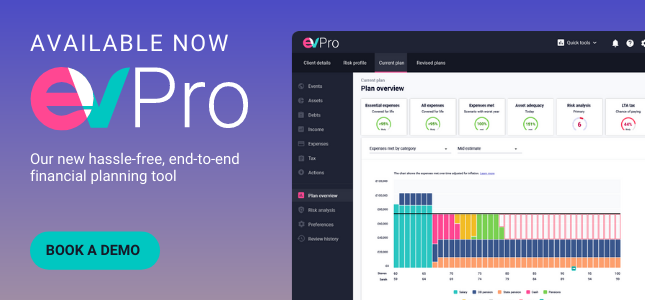The rise and rise of cash flow planning

Cash flow planning has roots in accountancy, used as a financial planning tool for companies to model the assets and income streams of businesses and create reviews against their current and future liabilities.
For almost 30 years, cash flow planning has enjoyed a steady growth in popularity within Financial Planning firms as part of the advice process.
Primarily this is due to how it helps clients visualise the complexities of their lifetime cash flow in a simple format. The secondary is how mapping out lifetime asset flows helps open discussions around capacity for loss and attitude to risk.
Cash flow Planning tools frame client questions such as;
- At what age can I afford to retire?
- Am I saving enough to meet my objectives?
- Can I continue to meet essential needs through to mortality?
- What would the impact of care fees be on our financial position?
- What would happen if there was another market crash?
Therefore, cash flow planning has the power to increase client engagement and drive awareness toward potential shortfalls.

Most financial planners place lifetime cashflow modelling front and centre of client interaction and reporting for this reason. It ultimately helps demonstrate value and builds a stress-tested financial plan that aligns with the clients' expectations, objectives, and risk appetite.
Benefits
Visually simplifying the inherent complexities of a financial plan is not the only benefit experienced by clients and financial planners. Accounting for things like taxation, lifetime allowances, inflation, and investment growth, give way to clearer financial decision making.- Clients now expect to receive
- Analysis of expenditure and future income requirements
- Confidence in reaching financial independence
- Shortfall signposting
- Protection requirement analysis
- Defined goals and objectives
- Tax planning
- Suitability of underlying investments
- Realistic stress tests and underlying assumptions
Challenges
The challenge for most financial planning firms is providing realistic forecasts that give consumers a better idea of their future finances.
Realistic forecasts are dependent on two key data sources/components.
- Client Data
- Model Data
As touched on earlier, core client data includes income, expenditure, asset values and debts. In addition, it expands to subjective goalposts such as retirement date and mortality.
Client data accuracy is best resolved through integration, where tools port information into the plan and remove the requirement for re-keying.
Whilst this input is essential, it’s not only client data that needs to be accurate. The assumptions used to model the data are equally important. The default assumptions built into software/modelling tools differ significantly and may be something that neither adviser nor client is comfortable with.
Traditionally, most financial planners have used deterministic models to project future investment returns. Although deterministic models benefit from simplicity, they rely on single assumptions about long-term average returns and inflation.
Deterministic
Deterministic (from determinism, which means lack of free will) is the opposite of random.
A Deterministic Model allows you to calculate a future event exactly, without the involvement of randomness. If something is deterministic, you have all the data necessary to predict (determine) the outcome with certainty.
Stochastic
Having a random probability distribution or pattern that may be analysed statistically but may not be predicted precisely.
A Stochastic Model has the capacity to handle uncertainties in the inputs applied. In addition, stochastic models possess some inherent randomness - the same set of parameter values and initial conditions will lead to an ensemble of different outputs.
Although deterministic forecasts can provide consistency between providers’ product projections, they do not give any concept of the risk or likelihood of a particular outcome. They also assume that investment returns will be the same every year even though the timing of high or low returns can significantly affect the final fund value.
Not allowing for sequencing risk and realistic levels of investment volatility will systematically result in over-estimating the retirement income that a drawdown plan can support.
Please find out more in our blog; Stochastic vs Deterministic Models: Understand the Pros and Cons
ssumptions
All sorts of models can produce similar outputs at a particular point in time. The difference comes in how an approach deals with investments addressing different horizons and over time and how consistently it responds to market movements.
Some existing models rely on a set or fixed-term to operate the model. This could create severely misleading outcomes unless the expected term for each client matches the underlying static time frame.
This form of stochastic modelling is typically referred to as an MVC model.
MVC stands for Mean, Variance and Covariance, where the mean is the average return. The variance is based on how much the market value of investment changes, and the covariance is a measure of how different types of assets behave relative to one another.
They typically assume the same average return irrespective of the underlying investment term.
As all advisers know, the risk and return characteristics of assets vary depending on the investment term.
MVC models should therefore be used very cautiously for longer-term projections, and an awareness of their limitations is critical when using the output.
In contrast, an ESG model (Economic Scenario Generator) can forecast outcomes for investments on a more realistic basis.
ESG forecasts do not depend on historical performance. This keeps the forecasts firmly looking forward to the current economic situation. An ESG model builds many possible sensible and realistic economic scenarios by reproducing the fundamental real-life characteristics of assets and looking at the resulting returns' range.
Cementing regular reviews
A final point on accuracy is the interpretation of the data set and the capability of the tech stack powering it. For example, once the Client and Model data are sound, can the financial planner develop the cash flow plan with clients live, face to face, as part of an interactive meeting? Are they able to explain the limitations of the underlying model along the way and create on the fly adjustments, revisions and back-solves to address shortfalls on the fly?
Mike Krzyzewski, the Basketball coach, famously said;
“I have a plan of action, but the game is a game of adjustments,”
and likewise, to be effective, a cash flow plan needs to be updated regularly to account for changes in circumstances and the suitability of the underlying investment structure.
Savings and investments can then be altered, income withdrawals reviewed, and insurance policies, wills and beneficiaries updated accordingly. Once a cash flow plan has been established as part of the financial decision-making process, it is straightforward to update.
Cash flow planning helps determine the return needed on investments and savings to meet the goals over a given period.
It supports open discussions with clients concerning how they may best achieve their goals and whether they need to consider trade-offs. For example, should they be saving more, changing investment risk, altering the timeframe?
Perhaps the client will be fortunate enough to pull the plug and retire early!
Conclusion
It is easy to understand the popularity and prevalence of cash flow within the planning process – it’s a key visual aide that helps Financial Planners demonstrate value and discuss objectives with a simple format.
I firmly believe, however, that unless the Cash Flow is joined up with accurately modelled asset allocations, aligned to the clients' risk profile and stress-tested consistently, clients expectations and objectives will not be easily met.
The reality must be faced that an accurate forecast may not be a favourable one.
It may not fill a prospective client will joyful buying signals. Still, it will be realistic, trackable and integrated with the financial planning journey, encouraging frequent reviews, increasing engagement and trust.
So what next?
